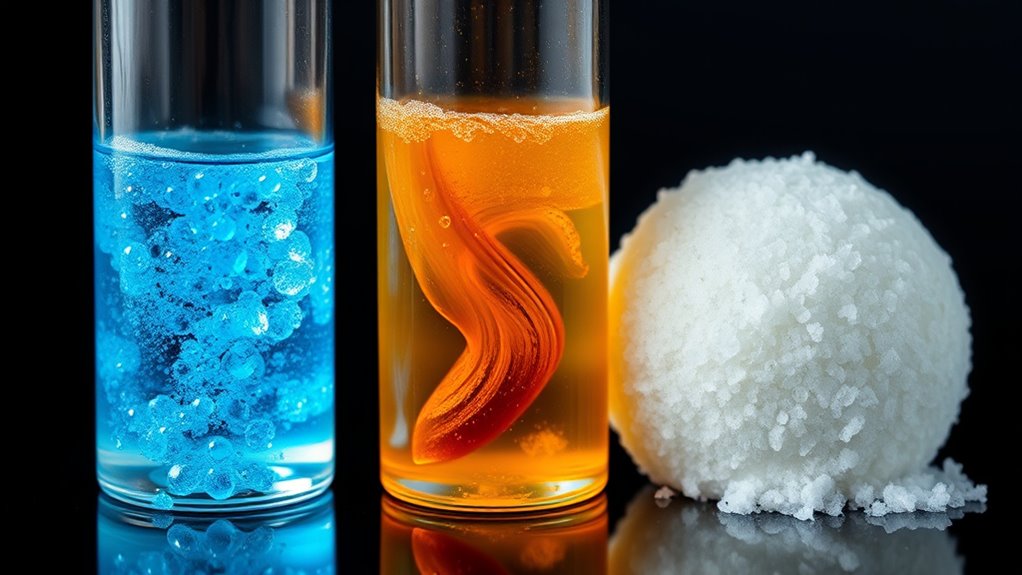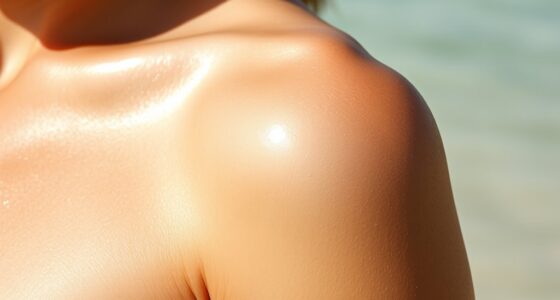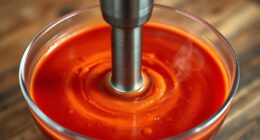Exfoliation tools come in three main types: physical, chemical, and enzyme. Physical exfoliants use scrubs or abrasive tools to manually slough off dead skin, giving instant smoothing results but risking irritation if overdone. Chemical exfoliants use acids like AHAs or BHAs to dissolve bonds between cells gradually, suitable for sensitive skin. Enzymes break down proteins naturally in dead cells, offering a gentle alternative. Keep exploring to discover how to choose the best method for your skin.
Key Takeaways
- Physical exfoliation involves manual removal of dead skin with abrasive tools or scrubs for immediate results.
- Chemical exfoliation uses acids like AHAs and BHAs to dissolve bonds between dead skin cells gradually.
- Enzyme exfoliation employs natural enzymes from fruits to gently break down proteins in dead skin cells.
- Each method varies in abrasiveness, suitability, and skin sensitivity, requiring proper selection and technique.
- Combining understanding of all three helps choose the best exfoliation method for specific skin types and goals.

Have you ever wondered how the skin naturally sheds dead cells and reveals a fresher, brighter layer beneath? This process, called exfoliation, is essential for healthy, radiant skin. While your body does a good job on its own, you can give it a hand through different exfoliation methods—namely physical, chemical, and enzyme exfoliation. Each approach works differently, but all aim to remove dull, dead skin cells to promote renewal and improve your skin’s texture and appearance.
Physical exfoliation involves manually sloughing off dead cells using abrasive tools or scrubs. Think of gentle scrubs containing small particles like sugar, salt, or jojoba beads. When you massage these over your skin, the friction lifts away the buildup of dead cells. It’s immediate and satisfying, but you need to be cautious. Too harsh or frequent scrubbing can irritate your skin or cause micro-tears, especially if your skin is sensitive. So, opt for gentle, circular motions and avoid overdoing it. Physical exfoliants are excellent for quick, targeted results, like smoothing rough patches or polishing your skin before makeup application.
Use gentle circular motions with physical scrubs to avoid irritation and micro-tears.
Chemical exfoliation, on the other hand, uses acids to dissolve the bonds holding dead skin cells together. Common ingredients include alpha hydroxy acids (AHAs) like glycolic and lactic acid, and beta hydroxy acids (BHAs) like salicylic acid. These acids penetrate your skin, breaking down the intercellular glue that keeps dead cells attached. The process is less abrasive than physical scrubbing, making it suitable for sensitive or acne-prone skin. Chemical exfoliants often come in serums, toners, or peels, and they work gradually to improve skin tone, reduce fine lines, and unclog pores. It’s important to start with lower concentrations and follow instructions carefully to avoid over-exfoliation, which can lead to redness or irritation.
Enzyme exfoliation offers a gentler alternative, especially for sensitive skin. Enzymes derived from fruits like papaya (papain) or pineapple (bromelain) break down proteins in dead skin cells, effectively dissolving them without harsh scrubbing or acids. This method is soothing and often used in masks or creams, making it ideal for those with reactive or easily irritated skin. Enzyme exfoliation provides a more natural approach to cell turnover, revealing a fresher complexion without the risk of irritation associated with physical or chemical methods. Additionally, choosing appropriate exfoliation tools and techniques can help optimize your routine and avoid damaging your skin barrier.
Understanding these three types of exfoliation helps you choose the best method for your skin type and goals. Whether you prefer the immediate results of physical scrubs, the gradual benefits of chemical acids, or the gentle touch of enzymes, incorporating exfoliation into your routine can transform your skin’s health and glow. Just remember to always listen to your skin and avoid overdoing it, ensuring your skin remains balanced, smooth, and luminous.
Frequently Asked Questions
How Does Exfoliation Affect Skin Aging Signs?
Exfoliation helps reduce skin aging signs by removing dead skin cells, revealing fresher, smoother skin. It boosts cell turnover, which can diminish fine lines, wrinkles, and age spots over time. Regular exfoliation also improves skin elasticity and promotes better absorption of skincare products. By encouraging healthy skin renewal, you can achieve a more youthful appearance and prevent premature aging caused by environmental damage and collagen breakdown.
Are There Natural Exfoliation Methods Without Chemicals?
Think of your skin as a garden that needs tending. Yes, there are natural exfoliation methods without chemicals—you can gently scrub with sugar or salt, or use soft brush tools to sweep away dead cells. Honey and oatmeal also act like soothing gardeners, removing impurities while nourishing your skin. These natural methods help you refresh your skin’s glow, revealing a healthier, more vibrant you without relying on synthetic chemicals.
Can Enzyme Exfoliants Be Used on Sensitive Skin?
Yes, enzyme exfoliants can be safe for sensitive skin if you choose the right formula. They work gently by breaking down dead skin cells without harsh abrasives or acids. Always do a patch test first and start with a lower concentration to see how your skin reacts. Look for enzyme products with soothing ingredients like aloe or chamomile to minimize irritation and guarantee a gentle, effective exfoliation.
What Are the Potential Risks of Over-Exfoliation?
Think of over-exfoliation as overwatering a delicate plant; it can cause damage. When you exfoliate too often or aggressively, you risk stripping away your skin’s natural barrier, leading to redness, irritation, and increased sensitivity. It might also cause breakouts, dryness, and premature aging. To avoid these pitfalls, follow recommended guidelines and listen to your skin’s signals, giving it time to recover and stay healthy.
How Often Should Physical Exfoliants Be Used?
You should use physical exfoliants no more than two to three times a week. Overusing them can cause irritation, redness, and microtears in your skin. Always listen to your skin’s response and adjust frequency accordingly. Use gentle pressure and choose products suitable for your skin type. If your skin feels irritated or starts to break out, cut back to prevent damage and maintain a healthy, smooth complexion.
Conclusion
With the Exfoliation Decoder, you hold the power to transform your skin like never before. Whether you choose physical, chemical, or enzyme methods, you’ll uncover radiant, youthful skin that feels almost miraculous. Imagine turning back the clock and revealing a glow so stunning, it’ll leave everyone breathless. Don’t wait—embrace these innovative techniques and revolutionize your skincare routine today. Your most radiant self is just a decode away, ready to shine brighter than you ever thought possible.









